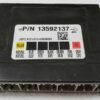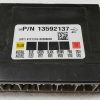Restore Your Vehicle’s Electrical System with a Plug-and-Play Solution
Are you dealing with baffling electrical issues in your Chevrolet Sonic or another GM vehicle? Intermittent power windows, flickering dash lights, malfunctioning door locks, or a security system that prevents your car from starting are classic signs of a failing Body Control Module (BCM). As the central hub for your car’s body electronics, a faulty BCM can create a cascade of frustrating and seemingly unrelated problems. Instead of facing a costly trip to the dealership for a new module and expensive programming fees, we offer a simple, reliable, and affordable solution.
This is a fully programmed BCM, ready for installation. We use the data from your original module to configure this replacement unit, ensuring it’s a perfect match for your vehicle’s specific options and VIN. The process is straightforward: after your purchase, you’ll ship your original BCM to us. Our expert technicians will transfer all the critical data to this replacement module and ship it right back to you, typically within 24-48 hours of receiving your original part. This means no additional programming, no security relearn procedures, and no surprise costs. It’s the most efficient way to get your car back to 100% functionality.
Common Signs of a Failing BCM
- ✔ Intermittent or non-working power windows, door locks, or interior lights.
- ✔ The security or anti-theft light is illuminated, causing a no-start condition.
- ✔ Erratic behavior from the dashboard gauges or warning lights.
- ✔ Horn, wipers, or turn signals activating on their own or not working at all.
- ✔ Communication error codes stored, such as U-series codes (e.g., U0140 – Lost Communication With BCM).
- ✔ Rapid battery drain while the vehicle is parked.
A Technician’s Notebook
I remember a 2016 Sonic that came into the shop with a laundry list of complaints from the owner. The radio would sometimes not turn on, the driver’s side window worked only when it wanted to, and twice the car had left him stranded with a flashing security light. He had already replaced the battery, but the gremlins persisted. A scan showed a dozen intermittent communication codes, all pointing to a network issue. Instead of chasing wires for hours, we went straight for the BCM. On these models, moisture intrusion or simple internal electronic failure is a common cause. By cloning his original module’s data onto our replacement BCM, we had him back on the road in an afternoon with all issues resolved. It’s a textbook example of how a single module can cause widespread, confusing symptoms.
A Straightforward Guide to Installation
- ✔ Safety First: Always disconnect the negative terminal from your vehicle’s battery before starting any electrical work.
- ✔ Locate the BCM: On the 2015-2018 Chevrolet Sonic, the BCM is located in the right-hand rear quarter panel area, typically behind the trunk trim. For other GM models, its location varies (e.g., under the steering column, left dash, or on the firewall).
- ✔ Disconnect and Remove: Carefully unplug the electrical connectors from the module. Press the release tabs firmly to avoid damaging them. Once disconnected, remove any bolts or clips holding the BCM in place and remove it from the vehicle.
- ✔ Install the New Module: Mount your newly programmed BCM in the same location and secure it with the original hardware.
- ✔ Reconnect Everything: Plug the electrical connectors back into the new BCM, ensuring they click securely into place. Reconnect the negative battery terminal.
- ✔ Final Checks: Start the vehicle and test all body functions—windows, locks, lights, wipers, etc.—to confirm the repair was successful. Note the post-installation procedures below, as some models may require an additional step.
Important Post-Installation Information
While our programming service makes this a plug-and-play repair for most vehicles, some systems may require recalibration after the BCM is replaced. This is normal and depends on your specific vehicle’s configuration.
- Airbag System Sync: If your airbag warning light is on after installation, a ‘Setup SDM Primary Key in BCM’ procedure must be performed with a professional scan tool. This syncs the airbag system with the new BCM.
- Brake Pedal Position Relearn: On some models, a brake pedal position sensor recalibration may be needed to ensure correct brake light operation and traction control function.
Disclaimer: Procedures can vary. Always consult a factory service manual or a qualified technician for guidance specific to your vehicle.
Verified Vehicle Compatibility
This BCM is compatible with a wide range of General Motors vehicles. Please verify your part number (13506935) or one of the interchangeable numbers (13592137, 13506936, 13587704, 13594764) matches your original module.
- Chevrolet Sonic: 2015, 2016, 2017, 2018 (RH rear quarter panel)
- Cadillac ATS: 2015, 2016 (on firewall)
- Cadillac CTS: 2015, 2016 (LH dash)
- Cadillac Escalade / ESV: 2015 (under steering column)
- Cadillac XTS: 2015 (left front hinge pillar)
- Chevrolet Corvette: 2015 (LH dash)
- Chevrolet Impala: 2015, 2016 (New Style, LH dash)
- Chevrolet Silverado 1500/2500/3500: 2015 (under steering column)
- Chevrolet Suburban 1500: 2015 (under steering column)
- Chevrolet Tahoe: 2015 (under steering column)
- GMC Sierra 1500/2500/3500 & Denali Models: 2015 (under steering column / LH firewall)
- GMC Yukon / Yukon XL 1500: 2015 (under steering column)
Frequently Asked Questions
How does this mail-in programming service work?
It’s simple. After you place your order, we will contact you with instructions to ship your original BCM to us. Once we receive it, our technicians clone the data to the replacement unit and ship it back to you, ready to install.
Do I really need to send you my old BCM?
Yes. Your original BCM contains the specific software, VIN, and security information for your vehicle’s options. Cloning this data is the only way to guarantee a true plug-and-play installation without needing a trip to the dealer.
What if my original BCM is completely dead or not communicating?
In most cases, even if the BCM has failed, we can still extract the necessary data. If your module has suffered extreme damage (fire, severe water corrosion), please contact us before ordering to discuss options.
Is this truly a plug-and-play part?
Yes, because we program it using your original module’s data, it will not require any additional programming or key relearning. You simply install it, and you’re ready to go. Some models may require minor system recalibrations as noted in the description.
Is there a core charge?
No, there is no core charge. You are not required to send your original part back to us after the repair, though we need it initially for the data transfer service.


